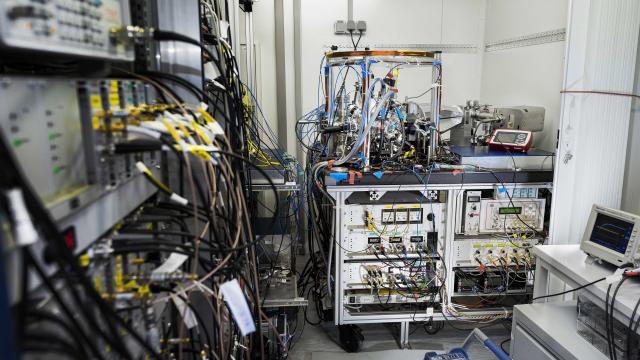With a new, “portable” atomic clock, scientists are measuring not what time it is but changes to time itself.
Portable can mean very different things, depending on whom you talk to. (Image: Christian Lisdat)
What do I mean? Researchers from a group of European labs have tested a next-generation atomic clock that isn’t bound to a laboratory. It isn’t something you’ll ever wear on your wrist, but it could one day make important measurements of the shape of the Earth and even dark matter.
“It was a proof of concept that optical clocks can be used as sensors for gravitational potential,” Cecilia Clivati, one of the study’s authors from Italy’s National Institute for Metrological Research, told me.
The clock part of the experiment is still bigger than a microwave, and must be mounted in a trailer. It isn’t the first portable atomic clock, but it is the first portable optical clock, the next generation of incredibly precise atomic clocks. This clock consists of strontium atoms held in place by lasers, cooled to just above absolute zero. Another laser excites the atom, and the interaction between the atom and laser creates oscillations of the atom’s electrons. Counting the oscillations, quadrillions per second, lets scientists calculate the time.

The trailer (Image: Christian Lisdat)
These clocks can do pretty awesome physics. They’re used to measure gravity’s strength, since stronger gravity makes time move more slowly. The researchers drove the clock to a spot high in the French Alps, made their measurements, then drove it to lower-altitude Turin and measured again, according to the paper published in Nature Physics.
The clock wasn’t perfect, Andrew Ludlow from the United States’ National Institute of Standards and Technology, who was not involved in the study, wrote in a commentary for Nature Physics. “There were periods of time when the portable optical clock would not function, and the accuracy of the measurements were limited below the capability of optical clocks.” Nor was the measurement as good as non-portable clocks. But this is only a first step. “The measurement campaign represents a very important proof of principle and a significant milestone.”
Who needs a portable atomic clock when we have perfectly good ones in labs? Rachel Godun from the United Kingdom’s National Physical Laboratory explained in a Physics viewpoint last year that researchers currently use satellites to compare measurements between different atomic clocks on Earth, but there’s a lot of noise that harms the accuracy of the comparison. Perhaps researchers could link the clocks with optical fibres, but that isn’t possible on intercontinental scales yet. “A transportable optical clock such as those now developed by Lisdat and colleagues and Huang and colleagues could travel between laboratory clocks located anywhere in the world,” she wrote, “and carry out a series of clock comparisons at a level surpassing both satellite-based methods and previously developed transportable clocks.”
Perhaps one day, these clocks could be used to create more precise maps of the Earth based on varying gravitational strength. They may even be useful for measuring dark matter, the stuff that seems to account for six times more of the universe’s mass than regular matter does. Because scientists can only spot dark matter via its gravitational force, a super-precise clock might be able to detect it for the first time on Earth.
